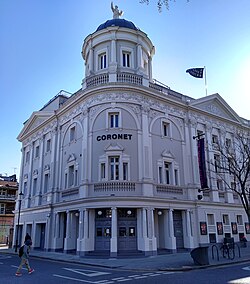|
Coronet Theatre, Notting Hill
The Coronet Theatre is a theatre located in Notting Hill, London. The building originated as an Off West End theatre in 1898. It became The Coronet Cinema in 1923. In 2014, it was acquired by The Print Room, a nearby theatre company (founded in Westbourne Grove in 2010[1]), which made it its new home. It produces a programme of theatre, art, dance, poetry, film and music.[2] The theatre is run by Artistic Director Anda Winters.[3] The Coronet Theatre currently operates using the 195-seat main auditorium, and a smaller, 100-seat black box theatre and studio space called The Print Room.[4][5] The Coronet Theatre stages lesser-known work by classic authors such as T.S Eliot, Arthur Miller and Harold Pinter, and new works by contemporary dramatists such as Brian Friel and Will Eno.[6] HistoryBuilding origins The Coronet Theatre was designed as a theatre by leading architect W. G. R. Sprague at a cost of £25,000 and opened in 1898. It was described in The Era as a "theatre of which the whole country may be proud".[7] Famous actors who appeared at the theatre in its early days included Ellen Terry and Sarah Bernhardt. It suffered, however, from being outside the traditional London theatrical district of the West End, whilst being sufficiently close to that district (unlike other provincial theatres) to find itself in competition with it. Switch to cinemaIn 1916, films were shown at the theatre for the first time, as part of variety programmes mixing live and filmed performances. In 1923, it became a cinema full-time, and capacity was reduced from 1,143 to 1,010 seats, but it retained, as it still does, its original theatre interior, consisting of stalls and two upper tiers (a dress circle and a gallery). However, the boxes on each side of the auditorium, next to the stage, were removed in 1931. The stage was blocked off, and the cinema screen is placed within the proscenium arch. The projection equipment was housed in the former dress circle bar. In 1931, the cinema became part of Gaumont British, and it was at this time that the theatre boxes were removed. In 1950, it was renamed the Gaumont and the upper tier was closed for seating, and capacity was therefore reduced to 196 in the dress circle and 319 in the stalls, a total of 515. In 1972, the Rank Organisation (which had taken over Gaumont) proposed to demolish the building, but a local campaign based upon its architectural merit and its interesting history secured its survival and, indeed, refurbishment. In 1977 it was sold by Rank to an independent cinema operator, and its name reverted to the Coronet. The new owners replaced the seating in the stalls so as to provide more legroom, reducing the total cinema capacity to 399 seats. In 1989, the building was again under threat, but it was protected by a Grade II listing[8] and the threat passed. In 1996, a second screen with seating for 151 was opened in the stage area. In 2004, the Coronet was acquired by the Kensington Temple, a large local Pentecostal church congregation. However, it continued to offer mainstream independent cinema programming, without any censorship or Christian slant. It was, for example, the cinema at which future prime minister David Cameron was reported to have watched Brokeback Mountain on its opening night. In June 2014, it was announced that the Coronet had been acquired by nearby fringe theatre The Print Room, which planned to make it its new home.[9] Print Room original premisesThe theatre began in a converted 1950s warehouse which had served as a graphic design workshop in Westbourne Grove. The venue had two spaces: an 80-seater studio, which was used for its larger productions, and a 40-seater space for smaller theatre pieces, play readings, and art exhibitions.[citation needed] Print Room moves to new premisesIn July 2014, it was announced that The Print Room was taking over the Coronet Cinema in Notting Hill Gate as its new home.[9] In May 2019, Print Room at the Coronet re-branded the company to the original 1898 name The Coronet Theatre.[citation needed] Productions
Awards and nominations
In popular cultureThe Coronet featured in the 1999 film Notting Hill, as the cinema where a sad Will Thacker (Hugh Grant) watches a film starring his romantic love interest Anna Scott (Julia Roberts) after they have separated. The cinema is also the home of the character Matt Hatter in the animated series Matt Hatter Chronicles. References
Bibliography
External links
|
||||||||||||||||||||||||||||||||||||
Portal di Ensiklopedia Dunia

